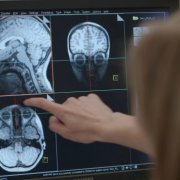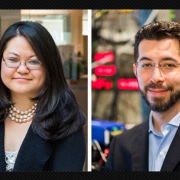April 18, 2018 - 2:00 pm
Mikhail Belkin, Ohio State University
Abstract:
A striking feature of modern supervised machine learning is its pervasive over-parametrization. Deep networks contain millions of parameters, often exceeding the number of data points by orders of magnitude. These networks are trained to nearly interpolate the data by driving the training...
A striking feature of modern supervised machine learning is its pervasive over-parametrization. Deep networks contain millions of parameters, often exceeding the number of data points by orders of magnitude. These networks are trained to nearly interpolate the data by driving the training...
April 13, 2018 - 4:30 pm
Christof Koch, CBMM EAC member, Allen Institute for Brain Science
Abstract:
Rapid advances in convolutional networks and other machine learning techniques, in combination with large data bases and the relentless hardware advances due to Moore’s Law, have brought us closer to the day when we will be able to have extended conversations with programmable systems,...
Rapid advances in convolutional networks and other machine learning techniques, in combination with large data bases and the relentless hardware advances due to Moore’s Law, have brought us closer to the day when we will be able to have extended conversations with programmable systems,...
April 12, 2018 - 4:30 pm
Marge Livingstone, CBMM, Harvard Medical
Host: Tomaso Poggio
This talk is open to the CBMM Community only
This talk is open to the CBMM Community only
April 6, 2018 - 1:30 pm
by Shannon Fischer
Go is an ancient board game that demands not only strategy and logic, but intuition, creativity, and subtlety—in other words, it’s a game of quintessentially human abilities. Or so it seemed, until Google’s DeepMind AI program, AlphaGo, roundly defeated the world’s top Go champion.
But ask it to read social cues or interpret what another person is thinking and it wouldn’t know where to start. It wouldn’t even understand that...
April 6, 2018 - 12:30 pm
The UNC School of Medicine has awarded the 18th Perl-UNC Neuroscience Prize to Winrich Freiwald, PhD, of The Rockefeller University and Doris Y. Tsao, PhD, of the California Institute of Technology for the discovery of brain mechanisms of face recognition. Drs. Freiwald and Tsao received the prize on April 12, 2018 in Chapel Hill.
UNC Press Release:
Freiwald, Tsao win 18th Perl-UNC Neuroscience Prize
Past winners include six scientists who...
April 4, 2018 - 11:15 am
We're very excited to announce the publication of the Brains, Minds, and Machines Summer Course on MIT OpenCourseWare!
Preparing this course to be released on OCW was a large task which required the help of many individuals. Thank you to everyone who contributed to the summer course, in ways large and small, and helped us to share this experience with the world through OCW!
Enjoy!Ellen Hildreth, CBMM Coordinator for Education
Course...
March 27, 2018 - 11:45 am
"MIT scientist among three recognized for the discovery of optogenetics
by Julie Pryor
Ed Boyden, the Y. Eva Tan Professor in Neurotechnology at MIT, has been named a recipient of the 2018 Canada Gairdner International Award — Canada’s most prestigious scientific prize — for his role in the discovery of light-gated ion channels and optogenetics, a technology to control brain activity with light.
Boyden’s work has given neuroscientists the...
March 23, 2018 - 4:00 pm
Prof. Josh McDermott
Please note room change. This meeting will be held in the McGover Reading Room Room #46-5165.
March 19, 2018 - 3:15 pm
We are glad to announce that registrations are open for the:
Regularization Methods for Machine Learning Course (RegML)
to be held 18 June - 22 June 2018, Genova Italy, in the heart of the Italian Riviera.
RegML is a 22 hours advanced machine learning course including theory classes and practical laboratory sessions. The course covers foundations as well as recent advances in Machine Learning with emphasis on high dimensional data and a core set...
March 16, 2018 - 4:00 pm
Dr. Andrei Barbu
March 12, 2018 - 11:45 am
"Children as young as 3 have brain network devoted to interpreting thoughts of other people.
by Anne Trafton
Humans use an ability known as theory of mind every time they make inferences about someone else’s mental state — what the other person believes, what they want, or why they are feeling happy, angry, or scared.
Behavioral studies have suggested that children begin succeeding at a key measure of this ability, known as the false-belief task...
March 6, 2018 - 5:45 pm
Neuroengineering leader appointed to new professorship at the McGovern Institute for Brain Research.
Julie Pryor | McGovern Institute for Brain Research
March 5, 2018, MIT News
Edward S. Boyden, a member of MIT’s McGovern Institute for Brain Research and the Media Lab, and an associate professor of brain and cognitive sciences and biological engineering at MIT, has been appointed the inaugural Y. Eva Tan Professor in Neurotechnology. The new...
March 6, 2018 - 10:00 am
Vision Sciences Society has announced that Prof. Nancy Kanwisher will receive the 2018 Davida Teller Award at an awards ceremony on May 21, 2018.
VSS established the Davida Teller Award in 2013. Davida was an exceptional scientist, mentor and colleague, who for many years led the field of visual development. The award is therefore given to an outstanding woman vision scientist with a strong history of mentoring.
Prof. Nancy Kanwisher's...
March 2, 2018 - 4:00 pm
Discussion will be moderated by Prof. Tomaso Poggio
MIT has announced a new institute wide initiative: The MIT Quest for Intelligence
Prof. Poggio will lead a discussion about the new initiative, the upcoming launch on March 1, 2018, and possible involvement of CBMM community members.
MIT Quest mission statement:
Forging connections between human...
Prof. Poggio will lead a discussion about the new initiative, the upcoming launch on March 1, 2018, and possible involvement of CBMM community members.
MIT Quest mission statement:
Forging connections between human...
February 20, 2018 - 5:30 pm
The National Academy of Sciences (NAS) awards two Troland Research Awards, in the amount of $75,000, annually to recognize "unusual achievement by young investigators (defined as no older than 40) and to further empirical research within the broad spectrum of experimental psychology." These awards will be presented on April 29, 2018 during the Academy's 155th annual meeting.
NAS has named Prof. Josh McDermott as one of the 2018 Troland Research...















